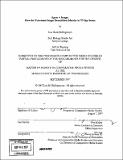| dc.contributor.advisor | Wyn Kelley. | en_US |
| dc.contributor.author | Bidlingmeyer, Lisa Marie | en_US |
| dc.contributor.other | Massachusetts Institute of Technology. Dept. of Comparative Media Studies. | en_US |
| dc.date.accessioned | 2008-04-23T14:35:01Z | |
| dc.date.available | 2008-04-23T14:35:01Z | |
| dc.date.copyright | 2007 | en_US |
| dc.date.issued | 2007 | en_US |
| dc.identifier.uri | http://hdl.handle.net/1721.1/41244 | |
| dc.description | Thesis (S.M.)--Massachusetts Institute of Technology, Dept. of Comparative Media Studies, 2007. | en_US |
| dc.description | Includes bibliographical references (leaves 105-107). | en_US |
| dc.description.abstract | This thesis explores the intersection of the television image with the presentation of self-identity. I examine two TV series in the spy genre -- Alias (2001 - 2006) and The Prisoner (1967 - 1968) -- discussing how each employs strategies of visual representation to present its protagonist as decentered or unfixed; in so doing, these programs complicate and problematize within their narratives the terms by which "subject" and "agency" have been traditionally understood and represented to popular TV audiences. This problematizing in turn opens up possibilities for detecting new modes of subject formation. This paper argues that television, communication tool and historical and cultural artifact, must be regarded equally as a visual medium. In fact, the TV image brings the enacted identity theorized by Judith Butler into direct contact with Henri Bergson's formulations of memory and image, creating characters and spaces within TV stories that vividly illustrate the limitations to and potentials for creativity within the domains of action and identity. In addition to Butler and Bergson, this paper turns additionally to Gilles Deleuze for an understanding of cinematic image and time, and to the concept of masquerade developed within feminist theory. In The Prisoner, a modern hero must make sense of a landscape of discontinuities and repetitions that challenge his ability to act, react, move, and escape. In Alias, a postmodern heroine must master the art of changing selves in order to move across spaces that, like her own identity, are conditional and are never what they initially appear. | en_US |
| dc.description.abstract | (cont.) In both series, the television image, freed from an obligation to represent only one thing while ruling out others and made multiple by the TV episode format, assumes a resonance over its duration that creates the conditions for the depiction of fluid and changeable spaces and characters. In both cases, the TV image repeated enables a paradigm shift where the depiction of a decentered protagonist, once exceptional, now becomes a normative subject on television. KEYWORDS: Alias -- Bergson -- Butler -- decentered subject -- Deleuze -- feminism identity -- image -- Jennifer Garner -- Patrick McGoohan -- The Prisoner -- spy shows -- television -- visual theory | en_US |
| dc.description.statementofresponsibility | by Lisa Marie Bidlingmeyer. | en_US |
| dc.format.extent | 107 leaves | en_US |
| dc.language.iso | eng | en_US |
| dc.publisher | Massachusetts Institute of Technology | en_US |
| dc.rights | M.I.T. theses are protected by
copyright. They may be viewed from this source for any purpose, but
reproduction or distribution in any format is prohibited without written
permission. See provided URL for inquiries about permission. | en_US |
| dc.rights.uri | http://dspace.mit.edu/handle/1721.1/7582 | en_US |
| dc.subject | Comparative Media Studies. | en_US |
| dc.title | Agent + Image : how the television image estabilizes identity in TV spy series | en_US |
| dc.title.alternative | How the TV images destabilizes identity in TV spy series | en_US |
| dc.type | Thesis | en_US |
| dc.description.degree | S.M. | en_US |
| dc.identifier.oclc | 213330576 | en_US |
